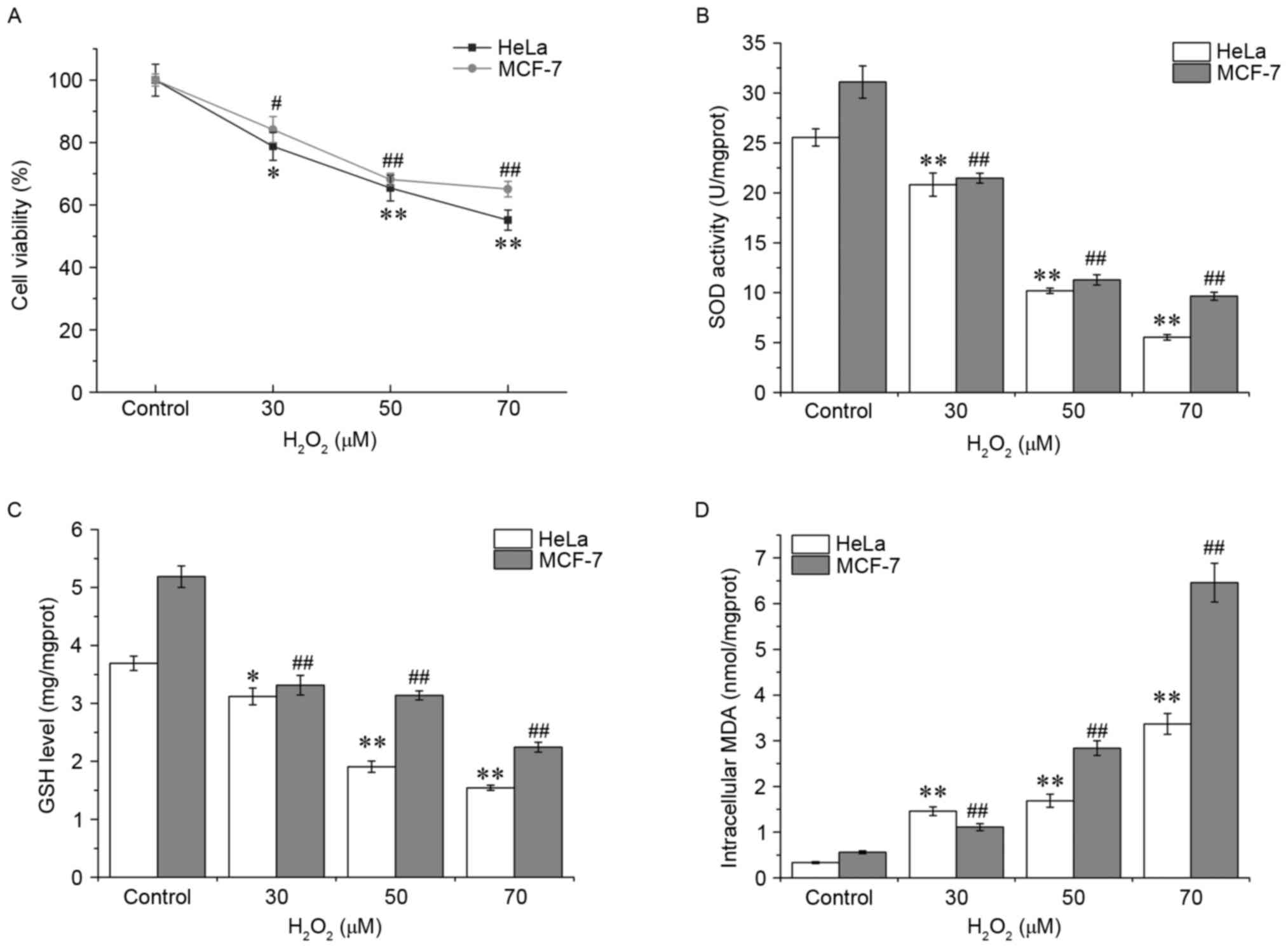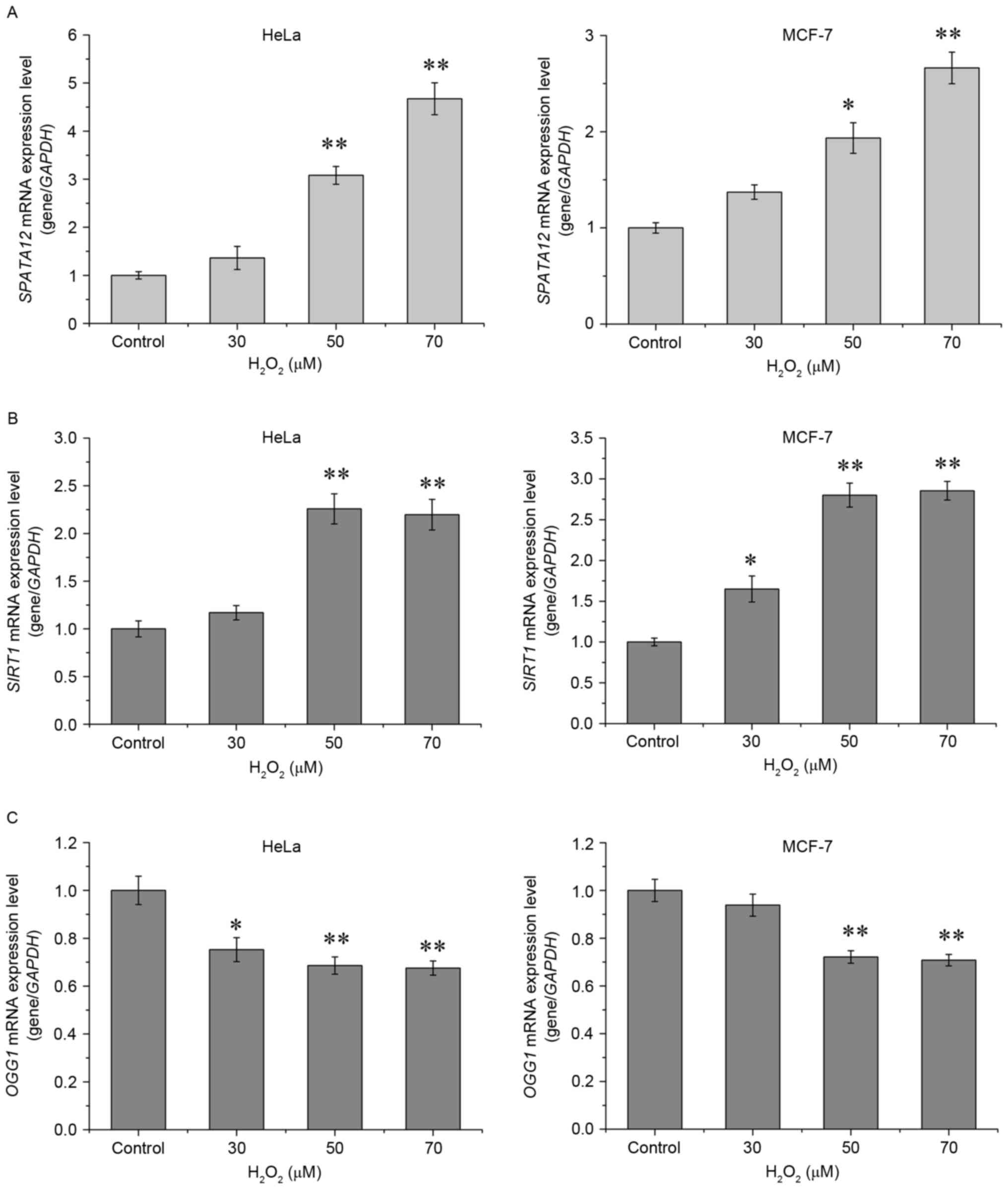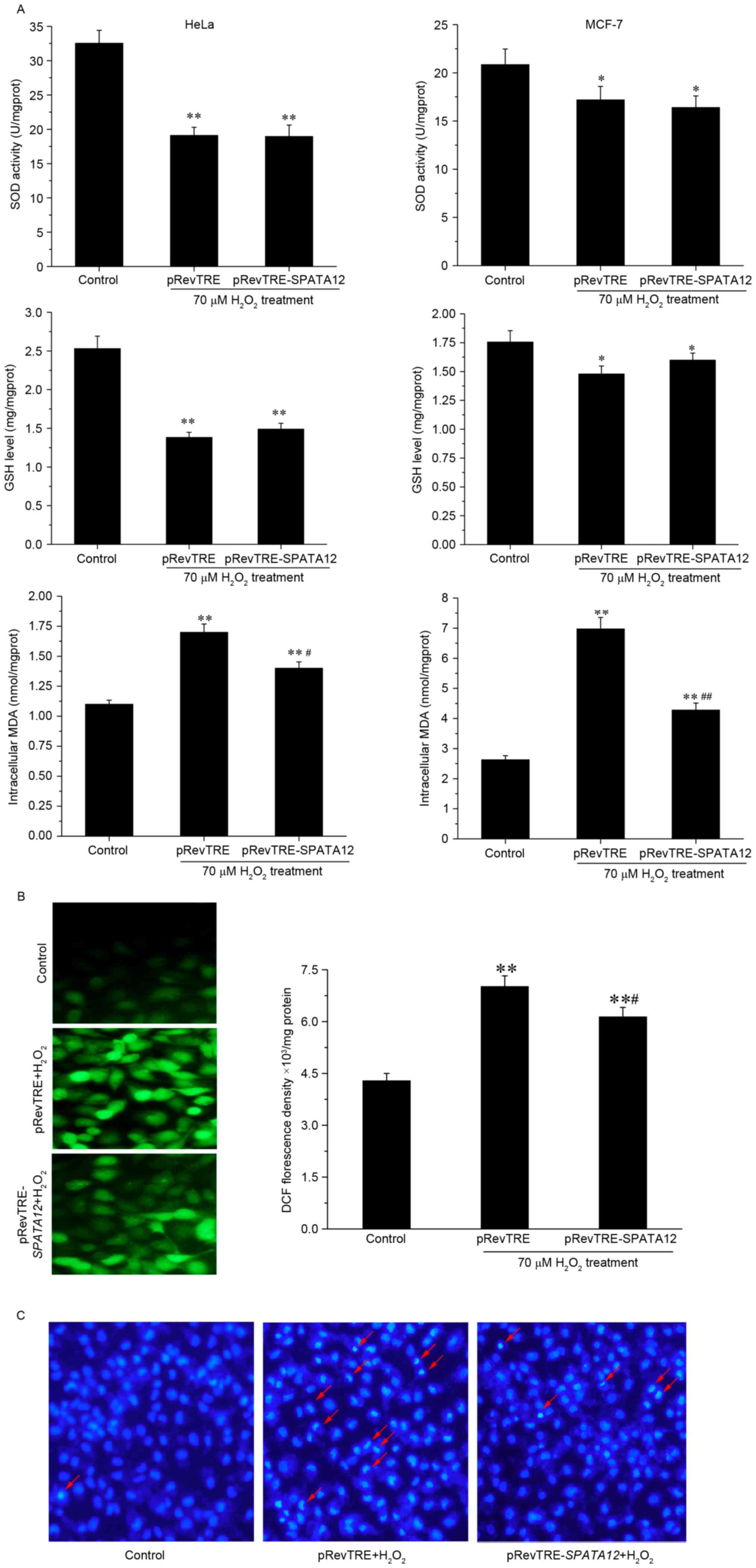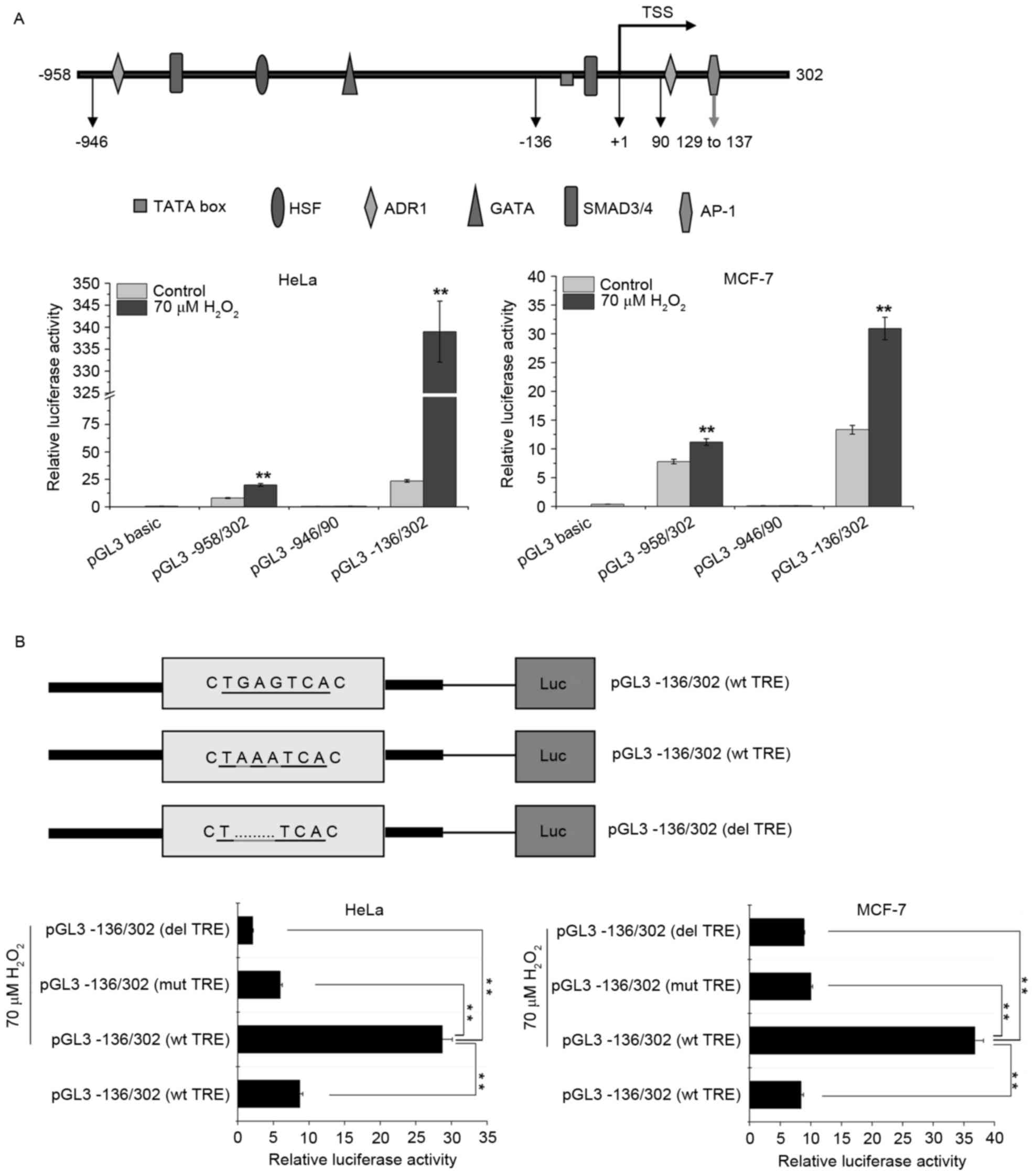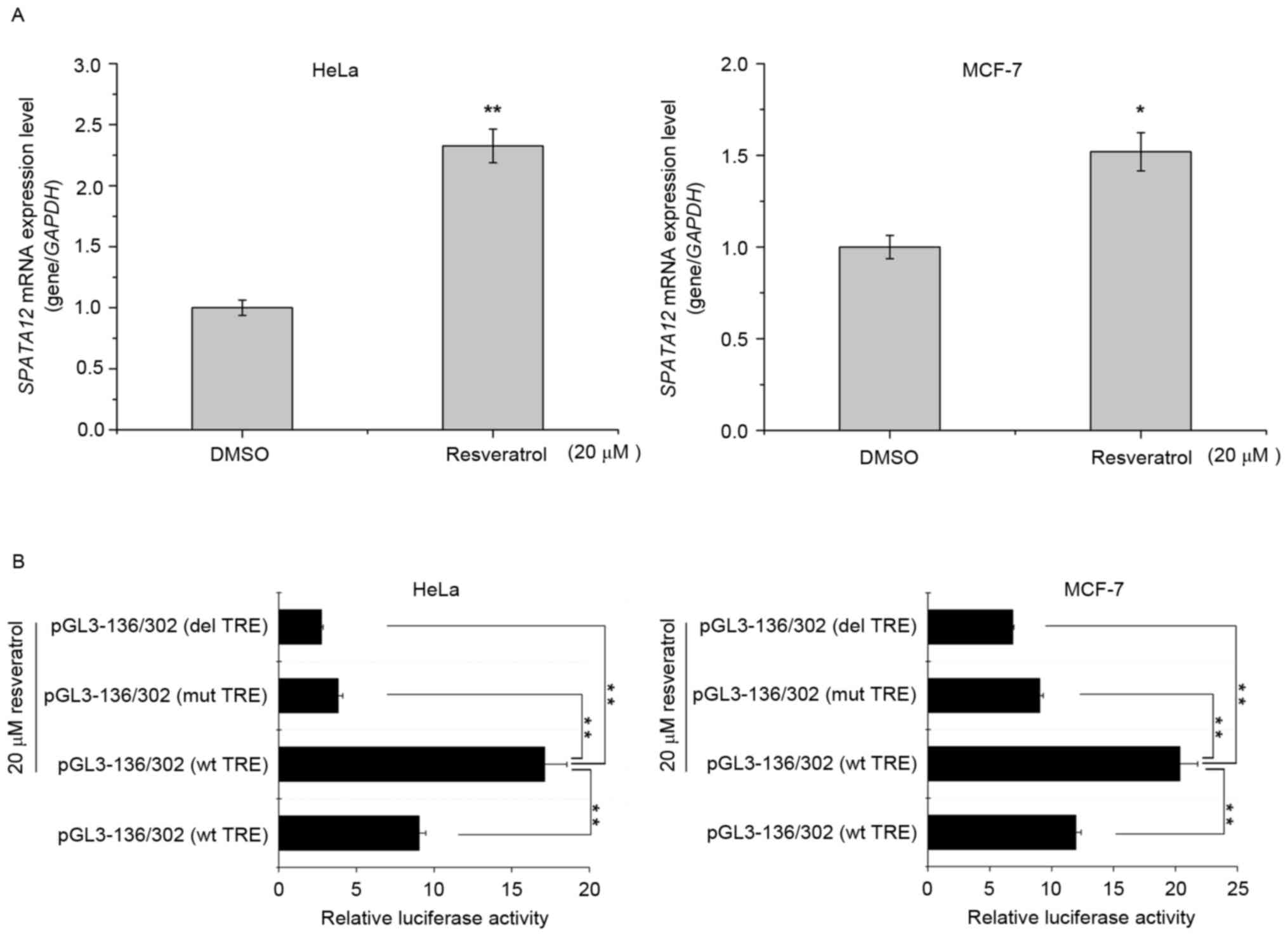Role and underlying mechanism of SPATA12 in oxidative damage
- Authors:
- Published online on: January 8, 2018 https://doi.org/10.3892/ol.2018.7749
- Pages: 3676-3684
-
Copyright: © Wu et al. This is an open access article distributed under the terms of Creative Commons Attribution License.
Abstract
Introduction
Reactive oxygen species (ROS) are a class of free radical including hydrogen peroxide (H2O2), superoxide anions (O2•-) and hydroxyl radicals (•OH) (1). Compared with molecular oxygen, ROS exhibit a high reaction activity and may induce the oxidative damage of important biological molecules, including DNA, proteins and lipids. As byproducts of cellular metabolism, ROS are tightly controlled by endogenous scavenging systems that involve catalase, superoxide dismutase (SOD) and glutathione (GSH) in living cells. Therefore, under normal circumstances, ROS exist in a physiological balance with biochemical antioxidants. However, when the levels of ROS exceed the capacity of the scavenging system, a disturbance of redox homeostasis occurs, resulting in oxidative damage and potentially, the induction of apoptosis (2,3).
Oxidative damage caused by ROS has been demonstrated to be associated with a number of diseases, including malignant tumors (4). Elevated ROS levels in cells cause genomic instability, and thereby promote the activation of oncogenes and inactivation of tumor suppressor genes (5). ROS may also affect the invasion and metastasis of cancer cells through the regulation of a number of important signal transduction pathways and molecules, including mitogen-activate protein kinases, phosphoinositide 3-kinase, phosphatase and tensin homolog, redox factor-1, nuclear factor (erythroid-derived 2)-like 2, SHC-transforming protein 1, ataxia telangiectasia mutated and protein tyrosine phosphatases, suggesting that ROS serve an important role in various stages of tumorigenesis (6–8).
The spermatogenesis-associated gene 12 (SPATA12), located on chromosome 3p14, was identified in our previous study by digital differential display assay (9). It was then demonstrated as a stage- and cell-type-specific gene that may be involved in the development of testicular maturation, and may negatively regulate β-catenin signaling during spermatogenesis (10). Another previous study identified that SPATA12 may be an inhibitor of testicular tumorigenesis (11). Through a yeast two-hybrid screening system, fluorescence microscopy and subcellular co-localization assays, an interaction between SPATA12 and chromodomain helicase DNA binding protein 2 (CHD2) in the nucleus was demonstrated. CHD2 is a chromatin-remodeling factor required for the maintenance of genomic stability, and is involved in the later stage of the DNA damage response pathway by affecting the transcriptional activity of p53 (12). Therefore, we hypothesized and verified that SPATA12 expression may be induced under ultraviolet (UV) C stress, and demonstrated that SPATA12 expression was associated with the inhibition of cellular proliferation subsequent to UVC-irradiated DNA damage (13). These data suggest that SPATA12 may serve an important role in maintaining genomic integrity. UV radiation exposure may induce ROS formation, potentially leading to cell death, genomic instability or malignant transformation (14). Therefore, it is important to understand whether and how SPATA12 responds to oxidative damage. The present study will provide a perspective for understanding the biological function of the SPATA12 gene in DNA damage induced by oxidative stress.
Materials and methods
Cell culture, cell treatment and transient transfection
The human cancer HeLa cell line [strain, CCL-2; American Type Culture Collection (ATCC), Manassas, VA, USA] and MCF-7 (strain, HTB22; ATCC) were cultured in RPMI-1640 (Gibco; Thermo Fisher Scientific, Inc., Waltham, MA, USA) supplemented with 10% bovine calf serum and 100 µg/ml penicillin and streptomycin. All cell lines were maintained in 5% CO2 and 95% humidity at 37°C.
HeLa or MCF-7 cells were treated with 0, 30, 50 or 70 µM H2O2 (Sigma-Aldrich; Merck KGaA, Darmstadt, Germany) for 8 h, and then allowed to recover for 4 h. For the resveratrol (Xi'an XiaoCao Botanical Development Co., Ltd., China) treatment, the cells were treated with 20 µM dissolved in dimethyl sulfoxide (DMSO) for 12 h. DMSO alone served as a control. For the transfection of empty pRevTRE (Promega Corporation, Madison, WI, USA) or pRevTRE-SPATA12 plasmids synthesized in the laboratory of the College of Biology, Hunan University (Changsha, China), cells were seeded in 6-well plates 24 h prior to transfection, and then treated with TurboFect™ in vitro Transfection Reagent (Fermentas; Thermo Fisher Scientific, Inc.) and the plasmids, according to the manufacturer's protocol. Subsequent to transfection, the cells were harvested, washed in PBS (137 mM NaCl, 2.7 mM KCl, 8.1 mM Na2HPO4, 1.5 mM KH2PO4, pH 7.4) and lysed in lysis buffer; cell pellets were used for further analyses.
Cell viability assay
An MTT assay was used to assess the viability of cells following treatment with 0, 30, 50 or 70 µM H2O2. HeLa or MCF-7 cells were plated at a density of 1×104 cells/100 µl in 96-well plates. Subsequent to H2O2 treatment, cells were treated with 10 µl MTT solution (final concentration, 0.5 mg/ml), and the plates were incubated for 4 h in a humidified incubator at 37°C to allow the MTT to be metabolized. The formazan crystals formed in the cells were solubilized with 20% sodium dodecyl sulfate in 50% aqueous N,N-dimethylformamide, and absorbance at 570 nm was measured with a microplate reader.
Determination of oxidative stress
HeLa or MCF-7 cells were exposed to 0, 30, 50 or 70 µM H2O2 for 8 h. Oxidative stress and levels of damage in the cells were assessed according to SOD activity and the GSH and malondialdehyde (MDA) content. All of these were determined, respectively, according to the manufacturer's protocols of an MDA assay kit (cat. no., A003-1), a SOD assay kit (cat. no., A001-1-1) and a reduced GSH assay kit (cat. no., A006-1) (all purchased from Nanjing Jiancheng Bioengineering Institute, Nanjing, China). The total protein concentration of the cells was determined with a BCA Protein Assay kit (Beijing Dingguo Changsheng Biotechnology Co., Ltd., Beijing, China).
RNA isolation
Total RNA was isolated by TRIzol® reagent (Takara Bio, Inc., Otsu, Japan) according to the manufacturer's protocol, digested by RNase-free DNase, and stored at −80°C until use. For quality control, RNA purity and integrity were evaluated by agarose gel electrophoresis and the optical density (OD)260/OD280 ratio, respectively.
Reverse transcription quantitative polymerase chain reaction (RT-qPCR)
Single stranded cDNA was synthesized using the first-strand PrimeScript™ RT Reagent kit with gDNA Eraser (Takara Bio, Inc.) according to the manufacturer's protocol. cDNA was subjected to qPCR using SYBR-Green PCR Master Mix (Tiangen Biotech, Co., Ltd., Beijing, China) and an MX3000 instrument (Stratagene; Agilent Technologies, Inc., Santa Clara, CA, USA). Following initial denaturation for 10 min at 95°C, 40–45 cycles of PCR were performed. Each cycle consisted of a denaturing period of 30 sec at 95°C, and annealing and extension periods for 60 sec at 60°C. The transcript amount for target genes were normalized to the human glyceraldehyde-3-phosphate dehydrogenase (GAPDH) to control the variability in expression levels and analyzed using the 2-ΔΔCq method (15). The primer sequences used for qPCR are listed in Table I.
Dual-luciferase reporter assay
All recombinant reporter plasmids of the SPATA12 promoter were constructed by our group in a previous study (16). Firefly and Renilla luciferase-containing plasmids (Promega Corporation) were co-transfected into cells using TurboFect™ in vitro Transfection Reagent, as previously. A total of 24 h after transfection, cells were treated as previously and harvested, and firefly and Renilla luciferase activities were determined using a Dual-Luciferase Reporter Assay system (Promega Corporation) on a Modulus™ luminometer (Turner BioSystems; Thermo Fisher Scientific, Inc.). All reporter assays were performed in triplicate. Non-treated cells were used as the control group.
Hoechst staining
Apoptosis was assessed by a Hoechst 33258 staining kit (Beyotime Institute of Biotechnology, Haimen, China). Following H2O2 treatment, the cells were stained according to the manufacturer's protocol. Then, the stained cells were observed with a fluorescence microscope (Eclipse TE300; Nikon Corporation, Tokyo, Japan).
Measurement of ROS
Intracellular ROS was measured by the oxidative conversion of the probe 2′,7′-dichlorofluorescin diacetate (DCFH-DA) into the fluorescent compound DCF using a ROS assay kit (Beyotime Institute of Biotechnology) according to the manufacturer's protocol. In brief, cells treated with or without H2O2 were collected by centrifugation and washed twice with 50 mM PBS. The cells from each well were then incubated with 10 µM DCFH-DA for 20 min at 37°C. Following two washes with PBS, the fluorescence of the cells was determined using a fluorescence spectrophotometer (model no. F-2500; Hitachi Ltd., Tokyo, Japan), containing FL solution software at excitation 488 nm/emission 529 nm, and fluorescence microscopy. Protein concentrations of the cells were determined with the BCA Protein Assay kit.
Statistical analysis
The results are expressed as the mean ± standard deviation. Experimental data analyses were performed by one-way analysis of variance with post hoc analysis using a Dunnett's test to determine the significant differences among groups. Statistical analyses were performed using SPSS software, version 17.0 (SPSS Inc., Chicago, IL, USA). P<0.05 was considered to indicate a statistically significant difference.
Results
Establishment of cellular oxidative damage model by H2O2
Oxidative stress was first assessed by measuring cell viability, and the data of the MTT assay demonstrated that H2O2 treatment decreased cell survival in HeLa and MCF-7 cells in a dose-dependent manner (Fig. 1A). HeLa cells appeared to be more vulnerable compared with the MCF-7 cells to H2O2. Subsequently, SOD activities and GSH and MDA levels were detected in the HeLa and MCF-7 cells. Compared with 0 µM H2O2 control group, the SOD activity and GSH content in HeLa cells with H2O2 exposure were decreased significantly in a concentration-dependent manner (P<0.01), whereas the MDA level was markedly increased, reaching a peak at 70 µM (P<0.01, Fig. 1B-D), indicating an increase in the levels of oxidative stress experienced by the cells. Similar patterns were observed in MCF-7 cells. These results suggested that the antioxidant defense system is damaged in cells following H2O2 exposure.
H2O2 exposure upregulates the expression of SPATA12 mRNA
The expression of SPATA12 mRNA was detected by qPCR in order to determine whether it was active in the cellular response to oxidative stress. As demonstrated in Fig. 2A, H2O2 significantly increased the mRNA expression of SPATA12 in the HeLa (P<0.01 at 50 and 70 µM) and in the MCF-7 cells (P<0.05 at 50 µM, P<0.01 at 70 µM). As a control, the expression levels of two antioxidant genes, Sirtuin 1 (SIRT1) and 8-oxoguanine DNA glycosylase 1 (OGG1), were also examined. SIRT1 and OGG1 are generally used as biomarkers to evaluate the level of oxidative stress in cells (17–19). Consistent with the previous studies, H2O2 at high concentrations (50 or 70 µM) markedly increased the level of SIRT1 mRNA (P<0.01, Fig. 2B), while oxidative stress suppressed the levels of OGG1 mRNA (P<0.01, Fig. 2C) (17,18). These results indicated that SPATA12 may be upregulated by H2O2 stimulation.
SPATA12 functions as an antioxidant
The levels of the aforementioned oxidative parameters (SOD activity, and GSH and MDA levels) were examined following SPATA12 gene transfection into HeLa or MCF-7 cells to understand its role in oxidative damage. Fig. 3A demonstrates that SPATA12 expression did not alter SOD activity or GSH content following oxidative damage to cells. However, it was observed that SPATA12 expression significantly reduced the induction of MDA by H2O2 (P<0.05 in HeLa cells, P<0.01 in MCF-7 cells). Subsequently, intracellular ROS production was assessed by measuring the oxidation of DCFH-DA, to investigate the potential protective action of SPATA12 against oxidative stress. DCFH-DA can cross cell membranes and is hydrolyzed enzymatically by intracellular esterases to form non-fluorescent DCFH. Intracellular ROS may oxidize DCFH into the fluorescent DCF; therefore, the intensity of DCF fluorescence is directly proportional to the level of intracellular ROS (20). Compared with the control group, SPATA12 attenuated the levels of H2O2-induced DCF green fluorescence (P<0.01 vs. control group, P<0.05 vs. pRevTRE group), indicating a reduction in the levels of oxidative stress experienced by the cells (Fig. 3B). Additionally, using a Hoechst staining experiment, a decrease in evident chromatin condensation was observed in the superposition field of view following SPATA12 gene transfection, which demonstrated that apoptosis induced by H2O2 (70 µM) was suppressed by SPATA12 expression (Fig. 3C). These data suggested that the SPATA12 gene functions as an antioxidant through attenuating the level of MDA and ROS, and inhibiting H2O2-induced apoptosis.
Activator protein-1 (AP-1) may be involved in the transcriptional upregulation of SPATA12 in response to H2O2
AP-1 is a transcription factor that is sensitive to oxidative stress (21). Our previous study demonstrated that the SPATA12 core promoter is located at 77–302 bp, and the AP-1 transcription factor binding site in this core region (Fig. 4A) is essential to the promoter activity and involved in the transcriptional upregulation of SPATA12 in response to UVC radiation (13,16). In order to investigate the change in SPATA12 promoter activity in response to H2O2 and the potential role of the AP-1 binding site during this oxidative damage process, the effect of H2O2 on the activity of a series of SPATA12 gene promoters, including the full-length promoter pGL3-958/302, and the truncated promoter fragments pGL3-946/90 and pGL3-136/302 that were constructed in our previous study (16), were analyzed using a dual luciferase reporter gene assay. The pGL3-136/302 and pGL3-958/302 fragments, with the exception of pGL3-946/90, contain the core promoter sequence. Fig. 4A indicates that the luciferase activity level of the pGL3-946/90 promoter fragment was unchanged, while the activity levels of pGL3-958/302 and pGL3-136/302 were increased significantly following H2O2 treatment (P<0.01), indicating that the SPATA12 gene was upregulated by H2O2 at the mRNA level. This result was concordant with the data obtained in the qPCR assay.
The AP-1 binding site within the SPATA12 core promoter (77–302 bp) encompasses the sequence 5′-TGAGTCA-3′, a core sequence in the AP-1 motif also known as the TPA responsive element (TRE) (22), is demonstrated in Fig. 4B. The point mutation construct pGL3-136/302 (mut 132–134) and the deletion construct pGL3-136/302 (del 132–134) were generated in our previous study (16). As demonstrated by Fig. 4B, the relative luciferase activity of the promoter in the cells with H2O2 stimulation was reduced when the TRE was mutated or deleted (P<0.01). This result revealed that TRE within the SPATA12 promoter is of major importance for the responsiveness of this transcription unit to H2O2 treatment, and that AP-1 may be involved in the H2O2-induced transcriptional upregulation of SPATA12.
Resveratrol upregulates the expression of SPATA12 via the AP-1 binding site
It has been suggested that resveratrol may improve the expression of AP-1 targeted genes by enhancing the activity of AP-1 (23). We hypothesized that resveratrol may increase the expression of SPATA12 by inducing AP-1. With an MTT assay (data not shown), the cytotoxicity of resveratrol at different concentrations was examined, and the nontoxic treatment of 20 µΜ was selected for use on cells for 12 h. As demonstrated in Fig. 5A, resveratrol treatment increased the expression of SPATA12 mRNA in HeLa and MCF-7 cells (P<0.01 in HeLa cells, P<0.05 in MCF-7 cells). Then, a dual luciferase reporter assay was used to detect the effect of resveratrol on the activity of the SPATA12 core promoter with the AP-1 binding site. As indicated in Fig. 5B, the luciferase activity of the pGL3-136/302 promoter (wild-type TRE) was increased following resveratrol treatment (P<0.01), but decreased markedly when TRE was mutated or deleted (P<0.01). These results indicated that resveratrol may upregulate the transcription level of SPATA12 via the AP-1 binding site, and it may be used as an activator of SPATA12.
Discussion
Cellular antioxidant defenses are complex, and act to minimize the levels of ROS while simultaneously allowing ROS to serve their useful functions in cell signaling and redox regulation (24). It has been demonstrated that a number of essential maintenance repair systems become deficient in tumor cells, resulting in the accumulation of cellular damage (25).
Based on our previous studies, we hypothesized that SPATA12 may exhibit antioxidant properties. As H2O2 is relatively stable and easy to use, it is an important tool for the study of various types of oxidative damage (26). In the present study, exogenous H2O2 was employed to induce oxidative stress and establish a model of cellular oxidative damage. As demonstrated in Fig. 1, compared with the control group, the SOD activity and the GSH level in the HeLa and MCF7 cells exposed to H2O2 were decreased significantly in a dose-dependent manner, whereas the MDA level was increased, indicating that oxidative stress was generated following H2O2 treatment. In addition, H2O2 may increase and decrease the expression levels of SIRT1 and OGG1, respectively, at the mRNA level, which is consistent with previous studies, and demonstrates oxidative damage in these cells (17,27). Using this model for cellular oxidative damage, an increase in SPATA12 expression was identified, suggesting that SPATA12 responded to oxidative stress.
Subsequently, the potential role of SPATA12 in the process of oxidative damage was considered. Fig. 3 demonstrated that the expression of SPATA12 reduced the MDA content, but not the SOD activity or GSH content. Under the same experimental conditions, SPATA12 was observed to reduce the production of ROS caused by H2O2. In order to further confirm the antioxidant function of the SPATA12 gene, Hoechst staining was performed, and the results indicated that SPATA12 inhibited H2O2-induced apoptosis. Taken together, these results implied that the SPATA12 gene may have an antioxidant role, and that this function may be achieved by decreasing the ROS and MDA content of cells.
In an attempt to obtain more insight into the underlying mechanism of the SPATA12 gene in oxidative damage, the changes in SPATA12 promoter activity in response to H2O2 stimulation and the possible roles of the transcription factor binding sites during this process were discussed. Following H2O2 treatment, the activity of the full-length promoter (pGL3-958/302) and the core promoter (pGL3-136/302) were increased, which indicated that SPATA12 expression may be induced by H2O2 at the mRNA level. This result was consistent with the data from the qPCR assay. Conversely, the activity of pGL3-946/90 was very low with or without H2O2 treatment.
We hypothesized that there may be a negative regulatory element located at the −946 to 90 bp region that may affect the transcriptional activity of the SPATA12 promoter; this requires further consideration and study in the future. Our previous study also demonstrated that the AP-1 binding site in the SPATA12 core promoter region is essential for the activity of SPATA12 promoter (16). AP-1 is a basic leucine zipper transcription factor, which regulates specific gene expression during the process of cell growth, development, differentiation and apoptosis. Through the leucine zipper, AP-1 identifies the TRE in the target genes' promoter regions. AP-1 is also an important oxidative stress-sensitive transcription factor. During oxidation, the activation of AP-1 is primarily mediated by the phosphorylation pathway, through c-Jun N-terminal kinase (JNK). Generally, JNK is activated by ROS in cells; the activated JNK consequently activates the c-Jun and c-Fos proteins, inducing the transcriptional activity of AP-1, which promotes the expression of target genes. AP-1 binding sites exist on the c-Jun gene promoter, and the activation of AP-1 may further induce the transcription of c-Jun by combining with this site, forming a positive feedback loop that induces a cascade (28). In the present study, the data from the dual luciferase reporter gene assay indicated that AP-1 mediated the response of SPATA12 to H2O2 stimulation, and the TRE element of the AP-1 binding site served a key role during this process. This suggests that SPATA12 may respond to oxidative damage via AP-1, and may have the ability to withstand cellular oxidative damage.
Due to the toxicity of synthetic antioxidants, including butylhydroxyanisole and butylhydroxytoluene, previous studies have attempted to identify natural active ingredients with antioxidant functions from plants and herbs for application as clinical chemotherapeutics or daily health care products (29). The efficacy and safety of an increasing number of Chinese herbal monomer components have been confirmed (30). Traditional Chinese Medicine features a variety of antioxidants, including agents that act as stimulating factors to activate the antioxidant cell signaling pathways, regulate the expression of downstream target genes and serve unique roles in the defense against oxidative damage (31). Thiel and Rössler (23), identified that resveratrol may activate the transcriptional expression of AP-1-targeted genes. Therefore, we hypothesized that resveratrol may also regulate the expression of SPATA12. The results of the qPCR assay performed in the present study confirmed this hypothesis, and the dual luciferase reporter gene assay revealed that AP-1 may have mediated the improvement of SPATA12 transcriptional activity by resveratrol.
In conclusion, the data of the present study suggest that the antioxidant properties of SPATA12 are associated with its ability to decrease the levels of ROS and MDA in tumor cells. Under oxidative stress, SPATA12 was able to inhibit oxidative damage and apoptosis induced by H2O2, to a certain extent. The regulation of AP-1 may be one mechanism to induce the antioxidant activity of SPATA12 during the process of oxidative DNA damage. In addition, resveratrol may activate the expression of SPATA12 via AP-1, which may be considered a potential activator of the SPATA12 gene.
Acknowledgements
The present study was supported by the National Natural Science Foundation of China (grant no. 81270735).
References
|
Han YH, Moon HJ, You BR, Kim SZ, Kim SH and Park WH: The effects of buthionine sulfoximine, diethyldithiocarbamate or 3-amino-1,2,4-triazole on propyl gallate-treated HeLa cells in relation to cell growth, reactive oxygen species and glutathione. Int J Mol Med. 24:261–268. 2009. | |
|
Ding B, Chi SG, Kim SH, Kang S, Cho JH, Kim DS and Cho NH: Role of p53 in antioxidant defense of HPV-positive cervical carcinoma cells following H2O2 exposure. J Cell Sci. 120:2284–2294. 2007. View Article : Google Scholar | |
|
Pallepati P and Averill-Bates DA: Activation of ER stress and apoptosis by hydrogen peroxide in HeLa cells: Protective role of mild heat preconditioning at 40°C. Biochim Biophys Acta. 1813:1987–1999. 2011. View Article : Google Scholar | |
|
Thanan R, Oikawa S, Hiraku Y, Ohnishi S, Ma N, Pinlaor S, Yongvanit P, Kawanishi S and Murata M: Oxidative stress and its significant roles in neurodegenerative diseases and cancer. Int J Mol Sci. 16:193–217. 2014. View Article : Google Scholar | |
|
Waris G and Ahsan H: Reactive oxygen species: Role in the development of cancer and various chronic conditions. J Carcinog. 5:142006. View Article : Google Scholar | |
|
Nishikawa M: Reactive oxygen species in tumor metastasis. Cancer Lett. 266:53–59. 2008. View Article : Google Scholar | |
|
Wu WS: The signaling mechanism of ROS in tumor progression. Cancer Metastasis Rev. 25:695–705. 2006. View Article : Google Scholar | |
|
Ray PD, Huang BW and Tsuji Y: Reactive oxygen species (ROS) homeostasis and redox regulation in cellular signaling. Cell Signal. 24:981–990. 2012. View Article : Google Scholar | |
|
Dan L, Lifang Y and Guangxiu L: Expression and possible functions of a novel gene SPATA12 in human testis. J Androl. 28:502–512. 2007. View Article : Google Scholar | |
|
Lin Y, Liu Z, Liu X, Zhang Y, Rong Z and Li D: Microarray-based analysis of the gene expression profile in GC-1 spg cells transfected with spermatogenesis associated gene 12. Int J Mol Med. 31:459–466. 2013. View Article : Google Scholar | |
|
Liu Z, Lin Y, Liu X, Yu W, Zhang Y and Li D: Experimental study of inhibition of tumor cell proliferation by a novel gene SPATA12. Zhong Nan Da Xue Xue Bao Yi Xue Ban. 37:222–227. 2012.(In Chinese). | |
|
Rajagopalan S: Functional analysis of chromodomain helicase DNA binding protein 2(CHD2) mediated genomic stability. PhD diss., Uni Tennessee. 2010. | |
|
Zhang Y, Yang L, Lin Y, Rong Z, Liu X and Li D: SPATA12 and its possible role in DNA damage induced by ultraviolet-C. PLoS One. 8:e782012013. View Article : Google Scholar | |
|
Nishigori C, Hattori Y and Toyokuni S: Role of reactive oxygen species in skin carcinogenesis. Antioxid Redox Signal. 6:561–570. 2004. View Article : Google Scholar | |
|
Livak KJ and Schmittgen TD: Analysis of relative gene expression data using real-time quantitative PCR and the 2(-Delta Delta C(T)) method. Methods. 25:402–408. 2001. View Article : Google Scholar | |
|
Li D, Lin Y, Liu Z, Zhang Y, Rong Z and Liu X: Transcriptional regulation of human novel gene SPATA12 promoter by AP-1 and HSF. Gene. 511:18–25. 2012. View Article : Google Scholar | |
|
Hasegawa K, Wakino S, Yoshioka K, Tatematsu S, Hara Y, Minakuchi H, Washida N, Tokuyama H, Hayashi K and Itoh H: Sirt1 protects against oxidative stress-induced renal tubular cell apoptosis by the bidirectional regulation of catalase expression. Biochem Biophys Res Commun. 372:51–56. 2008. View Article : Google Scholar | |
|
Yang L, Wang Y, Lin Z, Zhou X, Chen T, He H, Huang H, Yang T, Jiang Y, Xu W, et al: Mitochondrial OGG1 protects against PM2.5-induced oxidative DNA damage in BEAS-2B cells. Exp Mol Pathol. 99:365–373. 2015. View Article : Google Scholar | |
|
Zheng T and Lu Y: SIRT1 protects human lens epithelial cells against oxidative stress by inhibiting p53-dependent apoptosis. Curr Eye Res. 41:1068–1075. 2016. View Article : Google Scholar | |
|
Marimoutou M, Le Sage F, Smadja J, Lefebvre d'Hellencourt C, Gonthier MP and Robert-Da Silva C: Antioxidant polyphenol-rich extracts from the medicinal plants Antirhea borbonica, Doratoxylon apetalum and Gouania mauritiana protect 3T3-L1 preadipocytes against H2O2, TNFα and LPS inflammatory mediators by regulating the expression of superoxide dismutase and NF-κB genes. J Inflamm (Lond). 12:102015. View Article : Google Scholar | |
|
Ma Q: Transcriptional responses to oxidative stress: Pathological and toxicological implications. Pharmacol Ther. 125:376–393. 2010. View Article : Google Scholar | |
|
Wang M, Zhu K, Zhang L, Li L and Zhao J: Thioredoxin 1 protects astrocytes from oxidative stress by maintaining peroxiredoxin activity. Mol Med Rep. 13:2864–2870. 2016. View Article : Google Scholar | |
|
Thiel G and Rössler OG: Resveratrol stimulates AP-1-regulated gene transcription. Mol Nutr Food Res. 58:1402–1413. 2014. View Article : Google Scholar | |
|
Halliwell B: Reactive species and antioxidants. Redox biology is a fundamental theme of aerobic life. Plant Physiol. 141:312–322. 2006. View Article : Google Scholar | |
|
Poljsak B, Šuput D and Milisav I: Achieving the balance between ROS and antioxidants: When to use the synthetic antioxidants. Oxid Med Cell Longev. 2013:9567922013. View Article : Google Scholar | |
|
Hu TJ, Shuai XH, Chen JR, Wei YY and Zheng RL: Protective effect of a Potentilla anserine polysaccharide on oxidative damages in mice. Int J Biol Macromol. 45:279–283. 2009. View Article : Google Scholar | |
|
Kim KC, Lee IK, Kang KA, Kim HS, Kang SS and Hyun JW: Baicalein (5,6,7-trihydroxyflavone) reduces oxidative stress-induced DNA damage by upregulating the DNA repair system. Cell Biol Toxicol. 28:421–433. 2012. View Article : Google Scholar | |
|
Liebermann DA, Gregory B and Hoffman B: AP-1 (Fos/Jun) transcription factors in hematopoietic differentiation and apoptosis. Int J Oncol. 12:685–700. 1998. | |
|
Kahl R and Kappus H: Toxicology of the synthetic antioxidants BHA and BHT in comparison with the natural antioxidant vitamin E. Z Lebensm Unters Forsch. 196:329–338. 1993.(In German). View Article : Google Scholar | |
|
Matkowski A, Jamiołkowska-Kozlowska W and Nawrot I: Chinese medicinal herbs as source of antioxidant compounds-where tradition meets the future. Curr Med Chem. 20:984–1004. 2013. View Article : Google Scholar | |
|
Xiong L, Xie J, Song C, Liu J, Zheng J, Liu C, Zhang X, Li P and Wang F: The activation of Nrf2 and its downstream regulated genes mediates the antioxidative activities of xueshuan xinmaining tablet in human umbilical vein endothelial cells. Evid Based Complement Alternat Med. 2015:1872652015. View Article : Google Scholar |



